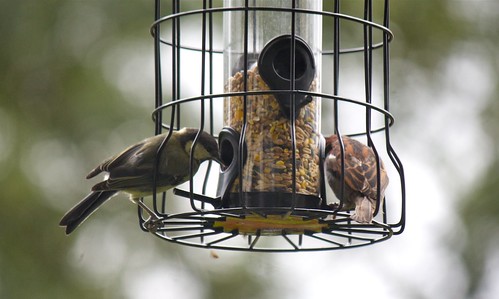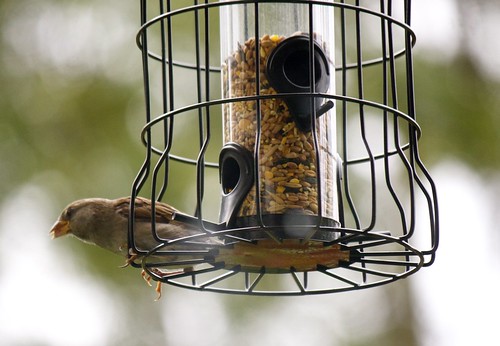Opposite the advertisement for the Grant Arms Hotel, Grantown-on-Spey (“The Wildlife Hotel”) in Autumn 2011’s Birds magazine from the RSPB, Caroline Nash tells us she’s helping to save sparrows. As you might know, sparrows—which for some of us are the epitome of garden birds—are declining in numbers across the UK. Nash is working on a project to find suitable habitats for the insects sparrows feed on, and is monitoring how sparrows use the different habitats the RSPB has set up in London parks.
Since last summer we’ve had two bird feeders hanging off the balcony above us. One contains peanuts, and is frequented by great tits, blue tits and various finches (mainly greenfinches, but I’ve seen a goldfinch too). Oh, and a squirrel who had the grace to look guilty when I drew back the bedroom curtains one Sunday morning. The other feeder contains bird seed (which does not, to my disappointment, grow into baby birds).
Anyway, this feeder has been empty for a few months. The reason for this is the dirty pigeons that infest London. When I installed the feeder, I used the smaller perches, because “Pigeons and other large birds” weren’t supposed to be able to stand on them. These pigeons found a way. So I then cut off the crossbar of the perches. The tits and finches could just about stand on them; the pigeons figured that they could hit the feeder and make the seed fall out, whence they could eat it (and crap all over my porch to boot). All my efforts at pest control failed. No amount of intense green laser beams in their eyes would make them stay away for long. I seriously considered investing in an air rifle but using it to best effect would involve some serious remodelling of the back door.
The time came for me to troop into Robert Dyas and buy some more peanuts for the first feeder. As I was there, considering giving up on seeds and getting a second peanut dispenser, I saw they had seed feeders that were supposedly squirrel- “and other large birds”-proof. Score.
I bought it, and a new bag of seed, and installed it on the porch. The result has been some very pissed off-looking pigeons, and—finally!—house sparrows in my garden.
I call that a win.





When are you going to invite them in for the Sunday roast?
Can you imagine the fuss if we were having chicken??
You have house sparrows in your garden??? … but where do the garden sparrows go?
That’ll be the chirping in the cupboard, then.
When I was a lusty student – I know, I know, seems hard to believe – I received a birthday present from my father. It was a long rectangular box marked
FOR THE MAN WHO LIKES TITS.
Inside was a net full of peanuts with a large label on it that read
THIS WILL ATTRACT MORE TITS THAN YOU CAN HANDLE.
I suspended it outside the window of my billet. It attracted the occasional chaffinch, but no tits.
There’s a moral in there, somewhere.
We’re not allowed to hang bird feeders out of the window, so we have our birds inside (inside the flat, not inside The Beast fortunately). Well, mostly: we had a swift hanging on the window screen on Sunday night.
One of my university roommates was upset that our cockatiels (we had three in the household) would occasionally eat chicken noodle soup from bowls on the table, but I argued that it was really not much different from us eating beef or pork. I think the birds just liked the taste of the broth, actually – never saw them eating a piece of meat.
My birdfeeder has a bar that will close off the openings to the seed chamber, if the bird weighs too much. This is meant to keep the stupid (and abundant) white-winged doves from eating/spilling everything, though they are welcome to hang out at the bird bath. The scrub jays are heavy enough to weight the bar down, but they’re also clever enough to have figured out a way to perch on the feeder and still access the seeds. House sparrows, purple finches, tufted titmice, and house finches are the most frequent visitors; in cooler months, I also keep a suet feeder.
I agree with Kristi – mammals can eat mammals, fish can eat fish, and birds can (and do) eat other birds (and eggs).
Speaking of eating other species: pigeons can be pretty tasty, but I don’t think I’d eat an urban, rubbish-fed one.
BTW, take this k. You now what to do with it 🙂
Ha, ha, Cath! So uncharacteristic for rpg.
My roommate yelled at the cockatiels and called them cannibals, which caused them first to adopt that tall and thin pose (outstretched neck, flattened feathers) on the table, and then fly around the apartment, shrieking. But we’d have had to boil one of the cockatiels or their (infertile) eggs in a broth, for them to be cannibals.
That’s why I commented… I usually wouldn’t 🙂
Further O/T, but the radio program Wait, Wait, Don’t Tell Me! had a segment on this weekend about Japanese scientists producing gelatin from human collagen (from cells grown in culture) and some sort of yeast. Predicted to “freak vegans the hell out.” Immediately following, was the song “She Drives Me Crazy”, by the Fine Young Cannibals. Cracked me up!
Wow, that took some bleary-eyed peering. I shall have to sack my editors.
As for Sunday lunch, in terms of taxonomy it would be like aliens inviting you over for dinner and serving up armadillo. In terms of morphology—I think appearances are important, when considering your food—it would be like serving gorilla steaks. Not cannibalism by a long chalk, but somewhat strange.
I’ve only had pigeon once, at a posh restaurant in Norfolk. I didn’t like it, largely because of the lead shot I had to dig out of it.
Grrl is usually a vegetarian, but she’ll happily tuck into a duck or goose at Christmas. Not parrots on the menu, though.
Legend has it that a professor of zoology in Cambridge would treat his students to ‘Five-Phylum Stew’. It’s fairly easy to come up with four … but the leap to five requires some head-scratching and potentially bizarre/disgusting ingredients.
Most stews are probably 5 phylum stews if you include the bacteria and fungi.
A professor of zoology would probably restrict the phyla to Kingdom Animalia. Though if it’s true that nematodes cover every surface on the planet, one would simply have to shop for Chordata, Mollusca, Arthropoda, and Echinodermata. If you’d rather include bryozoans, hemichordata, and onychophorans, count me right out.
Hmmm. The fifth could be either Peanut worms or Acorn worms. Eaten with a Spoon worm out of a goblet worm.
Odd fellows these zoologists.
This brings a whole new meaning to having a balanced diet and getting your “five a day”.
A former labmate had made it his mission to consume as many different branches of the tree of life as possible. For his leaving card, we made him a massive phylogenetic tree with check boxes at the end of each branch, and he spent the first half hour of his leaving party happily ticking boxes.
That’s just it – four phyla is easy. Five, though, calls for some ingenuity. One can easily imagine eating Chordata (fish, chicken, pigs, cows); Mollusca (calamari, snails, oysters); Arthropoda (fabulous Cromer crabs) and Echinodermata (sea-urchin roe, sea cucumbers like wot I ate in China) but after that things get esoteric. I can only think of Cnidaria – people, after all, have been known to eat jellyfish. Here is a rather fun recipe for jellyfish burgers. Nom, nom, nom, and -moreover – nom. I bet they taste like chicken.
http://www.thegastronaut.com/index/Recipes_Projects_6.1_Jellyfish_burgers.html
It’s so enjoyable reading the comments and laughing since it’s so wonderful scientist geeky 🙂
RPG> that feeded seems to let the sparrows be “safe” while eating. Or am I too optimistic? It would seem like the big bords won’t be able to eat either the sparrows or the feed? I was happy when I saw many hummingbirds around one of the feeders the other weekend, hadn’t seen that many at the same time beofre. Truly beutiful birds and exotic to me (can’t really say we have them in Sweden ^^ )
I had jellyfish at a Chinese wedding banquet once. The texture was quite nasty, but I liked the sauce!
I always found raw sea-urchin was one of the only two things in conference banquets in Japan that I couldn’t eat. Tasted like salty dust.
The other thing I couldn’t manage, which is completely irrelevant to the thread (sorry!) was Natto, aka ‘fermented soya bean paste left until well past the turn’ (properly ammoniacal, in my memory).
Chall, I’ve not ever seen any birds of prey in the garden (or even hovering above it). I suspect that they’d just wait for the small bird to exit, anyway.
The rest of you, you’re just mad.
I have enjoyed a jellyfish salad in a local Korean restaurant. It had an interesting crunch texture, iirc.
The problem you have with House Sparrows is that they’re all over here. Some bright spark introduced them to North America once upon a time, and as a result they’ve (ironically I guess, given your post) crowded out all kinds of indigenous sparrows.
We’ve had Chipping, American Tree, White-Fronted, White-Crowned, and Savannah Sparrows (all native species) in our back yard… infrequently. House Sparrows (which, by the way, are Weaver Finches, not Sparrows per se) are all over the freakin’ place.
As for birds of prey, I can verify that a Northern Harrier (aka “Marsh Hawk”) can be effective at getting rid of the occasional Mourning Dove. I suspect it would be quite happy with one or two of those pigeons of yours, too.
And on the topic of mammalian intruders, you ain’t seen nothing until you’ve had a full-grown Raccoon jumping on your birdbath and feeder. Imagine the effect a thirty or forty pound animal would have…
Birdbath and feeder? We had one in our house this weekend! Mr E Man heard it (I was listening to music) and went running into the kitchen, where it was eating the cat food (the cats were not happy, oh no, not at all). It took ages to get it out – even with a broom in its face, two people yelling and two cats hissing at it, it wouldn’t bloody back away!
R’pus, consider the sparrows payback for the grey squirrel.
@Cath – ARGH! I hates raccoons, hatesssssssssssssss em my precioussssssss. In the house, ick.
@rpg – fair enough.